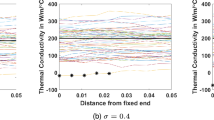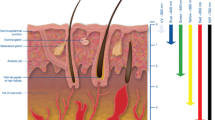Abstract
The model of heat source (MHS) which reflects the thermal interaction between materials and laser during processing determines the accuracy of simulation results. To acquire desirable simulations results, although various modifications of heat sources in the aspect of absorption process of laser by materials have been purposed, the distribution of laser power density (DLPD) in MHS is still modeled theoretically. However, in the actual situations of laser processing, the DLPD is definitely different from the ideal models. So, it is indispensable to build MHS using actual DLPD to improve the accuracy of simulation results. Besides, an automatic modeling method will be benefit to simplify the tedious pre-processing of simulations. This paper presents a modeling method and corresponding algorithm to model heat source using measured DLPD. This algorithm automatically processes original data to get modeling parameters and provides a step MHS combining with absorption models. Simulations and experiments of heat transfer in steel plates irradiated by laser prove the mothed and the step MHS. Moreover, the investigations of laser induced thermal-crack propagation in glass highlight the signification of modeling heat source based on actual DLPD and demonstrate the enormous application of this method in the simulation of laser processing.
摘要
激光热源模型反应了加工过程中激光对材料的能量作用,是仿真分析模型中的关键部分。该模型精度决定了激光加工仿真结果的准确性。激光热源主要包括作用于材料上的激光能量分布以及材料对能量的吸收两个部分。目前,对于激光热源模型的优化主要集中在吸收过程,而对激光能量分布的描述则采用理想模型。本文提出了一种根据实际激光能量分布自动建立热源模型的方法。该方法将激光能量分布的测试数据转化为灰度图像,并基于图像处理技术获得激光能量分布参数,同时与吸收模型结合,自动建立能够反应实际加工过程中激光能量分布的阶梯式热源模型。激光加热的实验及仿真分析表明,运用阶梯式热源模型能够准确地计算出激光加工过程中的温度场分布,证明了模型及建模方法的正确性。同时,相对于理想热源模型,阶梯式热源模型在激光热裂玻璃的仿真分析中表现出了更高的仿真精度。该建模方法为热源模型的优化提供了新思路。
Similar content being viewed by others
References
ZHU Zhuo, WU Jun-rui, WU Zhi-peng, et al. Femtosecond laser micro/nano fabrication for bioinspired superhydrophobic or underwater superoleophobic surfaces [J]. Journal of Central South University, 2021, 28(12): 3882–3906. DOI: https://doi.org/10.1007/s11771-021-4886-4.
WU Ting-ni, WU Zhi-peng, HE Yu-chun, et al. Femtosecond laser textured porous nanowire structured glass for enhanced thermal imaging [J]. Chinese Optics Letters, 2022(3): 153–156.
YIN Kai, WU Zhi-peng, WU Jun-rui, et al. Solar-driven thermal-wind synergistic effect on laser-textured superhydrophilic copper foam architectures for ultrahigh efficient vapor generation [J]. Applied Physics Letters, 2021, 118(21): 211905. DOI: https://doi.org/10.1063/5.0050623.
WIRTH F, WEGENER K. A physical modeling and predictive simulation of the laser cladding process [J]. Additive Manufacturing, 2018, 22: 307–319. DOI: https://doi.org/10.1016/j.addma.2018.05.017.
ANSARI P, REHMAN A, PITIR F, et al. Selective laser melting of 316L austenitic stainless steel: Detailed process understanding using multiphysics simulation and experimentation [J]. Metals, 2021, 11(7): 1076. DOI: https://doi.org/10.3390/met11071076.
CHENG Xiao-liang, YANG Li-jun, WANG Mao-lu, et al. Laser beam induced thermal-crack propagation for asymmetric linear cutting of silicon wafer [J]. Optics & Laser Technology, 2019, 120: 105765. DOI: https://doi.org/10.1016/j.optlastec.2019.105765.
ROY S, JUHA M, SHEPHARD M S, et al. Heat transfer model and finite element formulation for simulation of selective laser melting [J]. Computational Mechanics, 2018, 62(3): 273–284. DOI: https://doi.org/10.1007/s00466-017-1496-y.
ABLAT M A, QATTAWI A. Numerical simulation of sheet metal forming: A review [J]. The International Journal of Advanced Manufacturing Technology, 2017, 89(1–4): 1235–1250. DOI: https://doi.org/10.1007/s00170-016-9103-5.
LEE K H, YUN Gun-jin. A novel heat source model for analysis of melt pool evolution in selective laser melting process [J]. Additive Manufacturing, 2020, 36: 101497. DOI: https://doi.org/10.1016/j.addma.2020.101497.
UNNI A K, VASUDEVAN M. Determination of heat source model for simulating full penetration laser welding of 316 LN stainless steel by computational fluid dynamics [J]. Materials Today: Proceedings, 2021, 45: 4465–4471. DOI: https://doi.org/10.1016/j.matpr.2020.12.842.
D’OSTUNI S, LEO P, CASALINO G. FEM simulation of dissimilar aluminum titanium fiber laser welding using 2D and 3D Gaussian heat sources [J]. Metals, 2017, 7(8): 307. DOI: https://doi.org/10.3390/met7080307.
MIRKOOHI E, SEIVERS D E, GARMESTANI H, et al. Heat source modeling in selective laser melting [J]. Materials (Basel, Switzerland), 2019, 12(13): 2052. DOI: https://doi.org/10.3390/ma12132052.
EVDOKIMOV A, SPRINGER K, DOYNOV N, et al. Heat source model for laser beam welding of steel-aluminum lap joints [J]. The International Journal of Advanced Manufacturing Technology, 2017, 93(1–4): 709–716. DOI: https://doi.org/10.1007/s00170-017-0569-6.
WESSELS H, BODE T, WEIßENFELS C, et al. Investigation of heat source modeling for selective laser melting [J]. Computational Mechanics, 2019, 63(5): 949–970. DOI: https://doi.org/10.1007/s00466-018-1631-4.
BELITZKI A, MARDER C, HUISSEL A, et al. Automated heat source calibration for the numerical simulation of laser beam welded components [J]. Production Engineering, 2016, 10(2): 129–136. DOI: https://doi.org/10.1007/s11740-016-0664-9.
OKUNKOVA A, VOLOSOVA M, PERETYAGIN P, et al. Experimental approbation of selective laser melting of powders by the use of non-Gaussian power density distributions [J]. Physics Procedia, 2014, 56: 48–57. DOI: https://doi.org/10.1016/j.phpro.2014.08.095.
ZHU Hong-bo, FU Xi-hong, FAN Sheng-li, et al. The conversion from a Gaussian-like beam to a flat-top beam in the laser hardening processing using a fiber coupled diode laser source [J]. Optics & Laser Technology, 2020, 125: 106028. DOI: https://doi.org/10.1016/j.optlastec.2019.106028.
DUDUTIS J, STONYS R, RAČIUKAITIS G, et al. Glass dicing with elliptical Bessel beam [J]. Optics & Laser Technology, 2019, 111: 331–337. DOI: https://doi.org/10.1016/j.optlastec.2018.10.007.
ZHAI Zhao-yang, WANG Wen-jun, ZHAO Jie, et al. Influence of surface morphology on processing of C/SiC composites via femtosecond laser [J]. Composites Part A: Applied Science and Manufacturing, 2017, 102: 117–125. DOI: https://doi.org/10.1016/j.compositesa.2017.07.031.
AHSAN F, RAZMI J, LADANI L. Multi-physics modeling of laser interaction with surface in powder bed melting process [C]//Proceedings of ASME 2018 International Mechanical Engineering Congress and Exposition. Pittsburgh, Pennsylvania, USA, 2019. DOI: https://doi.org/10.1115/IMECE2018-86566.
SHALUPAEV S, ALEKSIEJUK M, NIKITJUK Y, et al. The analysis of laser thermosplitting of fragile materials by using of special geometry beams [J]. Archives of Metallurgy and Materials, 2011, 56(4): 1149–1155. DOI: https://doi.org/10.2478/v10172-011-0128-3.
MATSUURA T, TAKAI T, IWATA F. Local electrophoresis deposition assisted by laser trapping coupled with a spatial light modulator for three-dimensional microfabrication [J]. Japanese Journal of Applied Physics, 2017, 56(10): 105502. DOI: https://doi.org/10.7567/JJAP.56.105502.
HU M K. Visual pattern recognition by moment invariants [J]. IRE Transactions on Information Theory, 1962, 8(2): 179–187. DOI: https://doi.org/10.1109/TIT.1962.1057692.
CORTES C, VAPNIK V. Support-vector networks [J]. Machine Learning, 1995, 20(3): 273–297. DOI: https://doi.org/10.1007/BF00994018.
SUZAKI Y, TACHIBANA A. Measurement of the µm-sized radius of Gaussian laser beam using the scanning knife-edge [J]. Applied Optics, 1975, 14(12): 2809. DOI: https://doi.org/10.1364/ao.14.002809.
CAI Ye-cheng, WANG Mao-lu, ZHANG Hong-zhi, et al. Laser cutting sandwich structure glass-silicon-glass wafer with laser induced thermal-crack propagation [J]. Optics & Laser Technology, 2017, 93: 49–59. DOI: https://doi.org/10.1016/j.optlastec.2017.01.028.
NISAR S, SHEIKH M A, LI Lin, et al. The effect of material thickness, laser power and cutting speed on cut path deviation in high-power diode laser chip-free cutting of glass [J]. Optics & Laser Technology, 2010, 42(6): 1022–1031. DOI: https://doi.org/10.1016/j.optlastec.2010.01.024.
ZHAO Chun-yang, ZHANG Hong-zhi, WANG Yang. Semiconductor laser asymmetry cutting glass with laser induced thermal-crack propagation [J]. Optics and Lasers in Engineering, 2014, 63: 43–52. DOI: https://doi.org/10.1016/j.optlaseng.2014.06.008.
Funding
Project(2021YFF0500200) supported by the National Key R&D Program of China; Project(52105437) supported by the National Natural Science Foundation of China; Project(202006120184) supported by the Heilongjiang Provincial Postdoctoral Science Foundation, China; Project(LBH-Z20054) supported by the China Scholarship Council
Author information
Authors and Affiliations
Corresponding authors
Additional information
Contributors
The overarching research goals were developed by WANG Yang and YANG Li-jun. WANG Gen-wang programed the modeling method and performed the experiments and simulations. WANG Gen-wang and DING Ye analyzed the calculated and experimental results. The initial draft of the manuscript was written by WANG Gen-wang, DING Ye and GUAN Yan-chao. All authors replied to reviewers’ comments and revised the final version.
Conflict of interest
WANG Gen-wang, DING Ye, GUAN Yan-chao, WANG Yang and YANG Li-jun declare that they have no conflict of interest.
Rights and permissions
About this article
Cite this article
Wang, Gw., Ding, Y., Guan, Yc. et al. Model heat source using actual distribution of laser power density for simulation of laser processing. J. Cent. South Univ. 29, 3277–3293 (2022). https://doi.org/10.1007/s11771-022-5133-3
Received:
Accepted:
Published:
Issue Date:
DOI: https://doi.org/10.1007/s11771-022-5133-3




